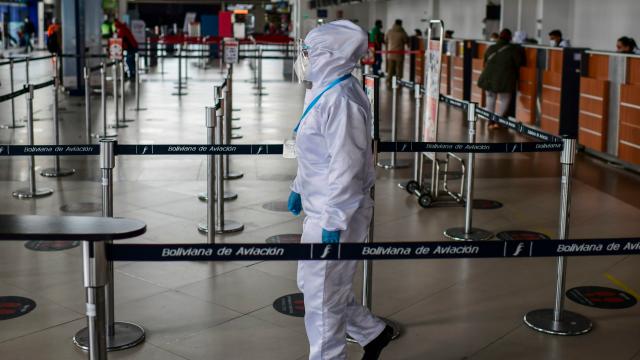One year ago, at the last minute, I decided to attend a presentation held by the Johns Hopkins Centre for Health Security at a Manhattan hotel facing Central Park. Epidemiologists, economists, and other public health experts ran a simulation of what a realistic pandemic would look in the modern world. The basic conclusion of the Event 201 exercise — that we were nowhere near ready to handle the next outbreak — has proven frightfully true over the past year.
To be very clear, Event 201 did not preview a “plan” for covid-19, as the conspiracy-soaked corners of the internet now argue. Their fictional germ was also a coronavirus related to SARS, but that’s nothing to raise an eyebrow at; scientists have long worried about the potential for coronaviruses in the wild to cross over to humans and spark the next major epidemic. There are also plenty of clear differences between the mock pandemic of the fictional CAPS (Coronavirus Acute Pulmonary Syndrome) and covid-19, such as their respective origins. Even if you wanted to humour the conspiracy angle, you’d have to wonder why anyone would publicly reveal their grand plan (for a never-explained goal) months before schedule, like a Z-grade Scooby Doo villain.
But having attended Event 201, I can say that it certainly foreshadowed at least some of the world’s response to covid-19. Go ahead and read this section from my write-up and see if any of it rings familiar:
Within the first few months, CAPS spread to several countries, aided by international travel and the fact that, like with many real-life diseases, not all people infected with the virus ended up sick and others only experienced mild flu-like symptoms. As it raged on in poorer and richer countries alike, governments and pundits squabbled about where to allocate money and resources, including experimental antiviral drugs. Social media outlets also fanned the flames by allowing trolls and even governments to spread disinformation about CAPS, such as blaming foreigners for the problem; that in turn made people even less likely to trust public health experts.
There have been genuinely unexpected bright spots during our real-life pandemic. Scientists around the world were able to quickly band together and study the coronavirus, leading to a diagnostic test in a matter of weeks. And the breakthrough pace in developing potential vaccines has been nothing short of remarkable. It’s possible, even likely, that we could have a successful vaccine ready to go into mass production by early next year. Many countries throughout Asia, Africa, and Europe have also had success in avoiding the worst of the viral illness, and some have even been able to resume some semblance of normal life through a hard-fought suppression of outbreaks within their borders.
“The positive surprise is that measures to flatten the curve worked so well — much better than expected,” Eric Toner, a senior scholar with the Centre for Health Security and project director of Event 201, said in an email. “The flip side is that many governments gave up on them too soon.”
Indeed, the broad strokes of Event 201’s forecast have been uncannily accurate.
The U.S., in particular, has failed by every metric to combat covid-19, leading to a death toll of over 220,000 Americans and counting — by far the deadliest epidemic seen in the country in over a century. Led by President Trump and the GOP, the federal government has routinely downplayed the pandemic, while Trump blames everyone but himself — especially China — for these deaths. This weekend, the White House’s Mark Meadows all but announced the country’s surrender to the coronavirus, stating it wasn’t possible to control its spread.
Though most if not all other countries have fared better than the U.S., much of the world is now ] facing a second wave, and over a million people worldwide have died. Hard-hit hospitals are still struggling to secure essential medical resources. Disinformation about covid-19 continues to spread largely unchecked on Facebook and Twitter, not to mention from Trump’s mouth.
“It has been a bit surreal to see so many of the story elements in Event 201 play out in real life, but also sad, because we included them in the scenario because they reflect many of the policy mistakes that are often made in large epidemics,” Toner said.
The moral of Event 201 wasn’t that a pandemic and its effects could be entirely prevented. Past a certain point, once a novel and highly contagious disease has gone global, there’s only so much you can do. The real hard work is supposed to come beforehand, as Toner himself noted when we spoke last year. Back then, he warned about the need to stockpile medical supplies — another concern that proved unfortunately correct during this pandemic.
[referenced id=”1268010″ url=”https://gizmodo.com.au/2020/08/look-at-this-horrible-horrible-map/” thumb=”https://gizmodo.com.au/wp-content/uploads/2020/08/21/fkayuy5mgt7uq0niassd-300×169.jpg” title=”Look at This Horrible, Horrible Map” excerpt=”Here’s the most depressing map you’re likely to see this week, courtesy of Anthony Fauci, head of the U.S. National Institute of Allergy and Infectious Diseases. The map, packaged in a recent paper co-written by Fauci, showcases the many other emerging diseases besides covid-19 that pose a threat to our…”]
Like all natural disasters, covid-19 will eventually come to an end. But it’s only a matter of time before the next potential pandemic rears its microscopic head. Hopefully, the experiences of covid-19 will provide enough of an incentive for countries and other parties to invest in the things that will either prevent pandemics from starting, like widescale disease surveillance, or in the crucial resources needed once a pandemic has begun, like protective equipment for medical workers. But just judging from our recent track record, that’s going to be a tall order.
“Event 201 illustrated, among other things, the need for robust, consistent, evidence-based, and truthful communications from governments,” Toner said. “We did anticipate that there could be disinformation from governments, but we underestimated the degree to which it would occur.”
